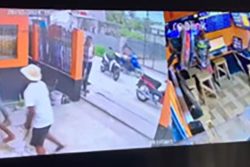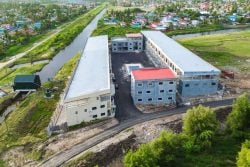Dear Editor,
“One senses that Prashad Nagar is a uniquely organized yet slowly changing community struggling to maintain an architectural balance between its original historical design and a push-back against the incursion of modern technology that lends itself to a higher standard of living. It is a built environment with a relatively short, but fascinating history.” Those are the words of Professor Baytoram Ramharack taken from his recent book ‘One One Dutty build a Village in Guyana: The story of Hari Prashad and Prashad Nagar.’ Hari Prashad (1898-1987), a second-generation descendant of Indian indentured labourers grew up in poverty and had become accustomed to “the harsh reality of a tough life and poor conditions.”
Hari’s entrepreneurial journey began as a woodcutter who sold firewood, but he worked himself to become a real estate mogul, and a captain of industry, leaving behind, Prashad Nagar, his most important legacy. Throughout his life, Hari’s sense of cultural awareness and education was elevated through understanding and interpretation of the stories depicted in the Ramayana. The Ramayana, he wrote “contained all the driving force and comfort for those who sought after the truth.” Hari was obviously wedded to a cultural and religious faith deeply rooted in the Indian culture, tradition, history, values, and dharma (one’s duty). He gave generously to community leaders who sought assistance from him.
A major turning point in Hari Prashad’s life was his decision to migrate to India with his wife and six children, leaving behind their home at Barr and Alexander Streets in August 1952. Although he had initially decided to reside in India permanently, Hari would later return to Guyana in 1953. He was fascinated with the organization, as well as the central and local planning that went into the construction of towns and villages he visited while residing in India. Hari was determined to construct his own modern-day urban village in Guyana – one resembling those that graced the cultural landscape of his ancestral India.
Hari purchased 76 acres of land from the Bookers conglomerate in 1958-59 as a first step towards building the post-World War II private housing scheme. The housing estate that became known as Prashad Nagar was parceled out into 404 house lots of various sizes ranging from 124’ X 60’ to 53’ X 80.’ The scheme was designed and approved for construction in May 1957. The lots were sold within a price range of 1,800 – 3,500 dollars to accommodate Guyanese of various economic backgrounds. The geographical location of the area, formerly referred to as “area H,” was primarily used for cultivating rice and as a pasture for raising animals.
The agreement of sale for the land on which Prashad Nagar was to be built was drafted by Hari Prashad and his friend, B.O. Adams. It became a much sought-after residential area. The Georgetown enclave became home to some well-known Guyanese, including David Chanderballi, Justice Rishi Persaud, Minister Vincent Teekah, Minister Vindhya Persaud, Justice Prem Persaud, Dr. Mohamed Shahabuddeen and Reepu Daman Persaud. Dr. Vivian Rambihar, a prominent cardiologist living in Canada, shared his vivid childhood recollections of Prashad Nagar:
“Prashad Nagar is the neighbourhood I knew best, especially our street, Munipur Street. Trinidadian Literature Nobel Laureate Vidya Naipaul had written a book, Miguel Street, around that time, and we sort of thought of our street as having colourful characters as his Miguel Street and deserving of a book too.” Hari named all the streets in Prashad Nagar after members of his family and friends, including: Delhi Street, Shantinikatan Street, Amla Avenue East, Amla Avenue West, Rohintal Street, Bombay Terrace, Damanbir Terrace, Jasmatbina Terrace, Sachibazaar Street, Kaka Street, Bisessar Avenue, Purshottam Street, Santram Street, Deobirana Street, Agra Street, Munipur Street, Cheddi Street, Shribasant Street, Chandranagar Street, Premniranjan Place, Rampersaud Street, Puna Street, Ganges Street, and Amla Avenue.
The empty plots were named Nehru Park and Gandhi Park. Santram Street was named after Hari Prashad’s father. Two areas, Amla Avenue East and Amla Avenue West, were named after Hari’s wife, demonstrating Hari’s love and appreciation for his companion who bore him eight children (eleven altogether). Hari owned lots 9 and 10 on Delhi Street, opposite those of his son-in-law, former Justice Prem Persaud who owned lots 11 and 12. The fact that most of the names of his village bore “Hindu names” was an affirmation of the important value Hari placed upon his Indian culture and religion. This fascinating story of Hari Prashad, written by Dr. Baytoram Ramharack, a Guyana Prize winner, will be launched, virtually, at a ZOOM Public Meeting on Sunday, June 23 by the Indo-Caribbean Cultural Centre.
Sincerely,
Dr. Kumar Mahabir
Anthropologist, University of
Guyana




